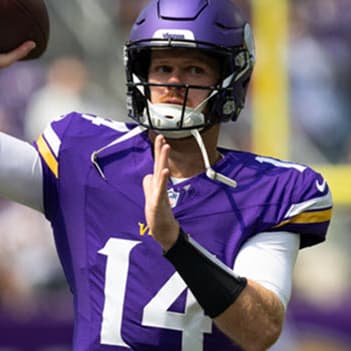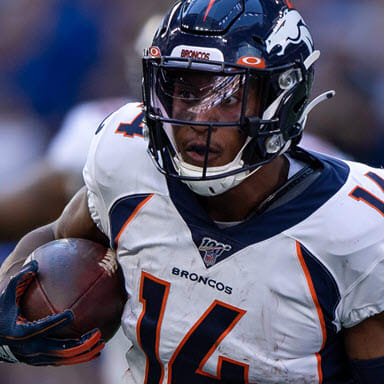This article is part of our Injury Analysis series.
Hamstring strains appear to be the trendy injury for running backs this season, with multiple backs, including Dalvin Cook, Leonard Fournette and Melvin Gordon all missing time with the injury. In the cases of Cook and Fournette, the symptoms and limitations presented by their respective injuries have lingered for weeks and kept them sidelined for a majority of the season. Their delayed returns are linked to the body's natural healing response and the delicate balance that's required to complete the process.
When scar tissue is utilized to fill in the gaps caused by trauma, it's repeatedly remodeled using specialized protein. By constantly building up and breaking down these fibers, the overall integrity of the newly formed tissues improves. However, a substantial amount of time is needed for the scar tissue to display the same biomechanical properties as healthy muscle tissue. Unfortunately, an injured athlete may feel okay and even display normal functional movement while this remodeling is ongoing. Re-injury is a common occurrence if the athlete returns to play prematurely and subjects this still vulnerable tissue to high demands. Sadly, the entire healing sequence must begin again following a new injury or aggravation.
The Jaguars have witnessed this complicated scenario firsthand as Fournette continues to work his way back from his hamstring strain. Initially injured in the season opener, the second-year running back irritated the injury in his first game back in Week 4. He has not appeared in a game since. The team is optimistic he will be
Hamstring strains appear to be the trendy injury for running backs this season, with multiple backs, including Dalvin Cook, Leonard Fournette and Melvin Gordon all missing time with the injury. In the cases of Cook and Fournette, the symptoms and limitations presented by their respective injuries have lingered for weeks and kept them sidelined for a majority of the season. Their delayed returns are linked to the body's natural healing response and the delicate balance that's required to complete the process.
When scar tissue is utilized to fill in the gaps caused by trauma, it's repeatedly remodeled using specialized protein. By constantly building up and breaking down these fibers, the overall integrity of the newly formed tissues improves. However, a substantial amount of time is needed for the scar tissue to display the same biomechanical properties as healthy muscle tissue. Unfortunately, an injured athlete may feel okay and even display normal functional movement while this remodeling is ongoing. Re-injury is a common occurrence if the athlete returns to play prematurely and subjects this still vulnerable tissue to high demands. Sadly, the entire healing sequence must begin again following a new injury or aggravation.
The Jaguars have witnessed this complicated scenario firsthand as Fournette continues to work his way back from his hamstring strain. Initially injured in the season opener, the second-year running back irritated the injury in his first game back in Week 4. He has not appeared in a game since. The team is optimistic he will be ready to return following their Week 9 bye. However, look for Jacksonville to ease him back into the mix, leaning heavily on the recently acquired Carlos Hyde. This creates a less than ideal situation for fantasy owners, hoping for a noticeable contribution from Fournette. I would consider keeping him on the bench through Week 11 to get a better idea of his overall health and role moving forward.
Cook is keenly aware of the intrinsic balance between feeling okay and physically being ready to return to activity following a hamstring strain. The Vikings running back strained his hamstring late in the team's eventual tie with the Packers and suffered a setback two weeks later against the Rams. He hasn't played since. Now he is reportedly, "feeling great" but remains hesitant to overextend himself. It seems plausible and likely that Minnesota plays it safe and holds him out through their Week 10 bye. The cautious approach would be a safe and prudent play, while making Latavius Murray fantasy relevant for at least one more week.
In Los Angeles, the Chargers also took advantage of the off week to buy more time for their running back to recuperate from his own hamstring injury. Melvin Gordon did not play when the team traveled to London but has improved with the extended time off. The team is optimistic he will return after missing just one game, though fantasy owners would be wise to scale back their expectations and remember the risk of injury will linger for the immediate future.
Tampa Bay rookie Ronald Jones II is also slated to miss multiple weeks after straining his hamstring against the Bengals. It's beginning to look like a lost rookie season for the second-round pick, who was just beginning to show signs of life. Peyton Barber remains the lead back for the Buccaneers.
Turf Burns
Matt Breida: The San Francisco running back continues to appear in the lineup despite a myriad of injuries that have threatened his availability. He endured shoulder and knee injuries earlier in the year and has been dealing with a sprained ankle over the past few weeks. However, he has remained the lead back for the 49ers week-in and week-out. This shouldn't change in Week 9, despite the short week of preparation. The Raiders provide an intriguing matchup for Breida, likely making him a solid RB2 play.
Tyreek Hill: The speedy receiver made an early exit from the Chiefs' win over the Broncos after suffering a groin injury. Even the mildest strain could prove limiting for a receiver, particularly one that depends on his speed. Keep an eye on his level of participation throughout the week and don't be surprised if Hill ends up being a game-time decision.
Cooper Kupp: The Rams expect to have Cupp back in uniform for Week 9. The wideout hasn't played since suffering a sprained medial collateral ligament (MCL) in his knee in Week 6 against Denver. The MCL provides the knee with stability during lateral movement and will be tested when Kupp makes hard cuts in his routes. However, the area can be stabilized with a brace, and Kupp shouldn't be enormously limited upon his return.
Will Fuller and Keke Coutee: For the second straight year, the Texans offense has lost a key contributor to a midseason ACL tear. Last year, quarterback Deshaun Watson suffered the injury in practice, and now Fuller will miss the remainder of the year after tearing his ACL late in Thursday's win over Miami. Fuller is expected to undergo surgery in the near future to repair the damage and will likely see his recovery spill over into the 2019 season. Coutee would be the biggest beneficiary of Fuller's absence but he's dealing with an injury of his own. The rookie receiver is nursing a strained hamstring, and coach Bill O'Brien remains noncommittal on Coutee's status for the team's matchup against the Broncos. Sammie Coates and undrafted rookie Vyncint Smith could see their snap count increase if Coutee is unable to play.
Ryan Tannehill: Coach Adam Gase admitted Tannehill's recovery remains fluid, and the team is unsure of how much he will physically be able to do this week in practice. Tannehill is currently recovering from an acromioclavicular (AC) sprain on his throwing arm and only recently began throwing a tennis ball. While the AC joint acts as more of a strut while throwing, it remains an important link in throwing mechanics. As a result, it seems likely we'll see Brock Osweiler for at least one more week.










